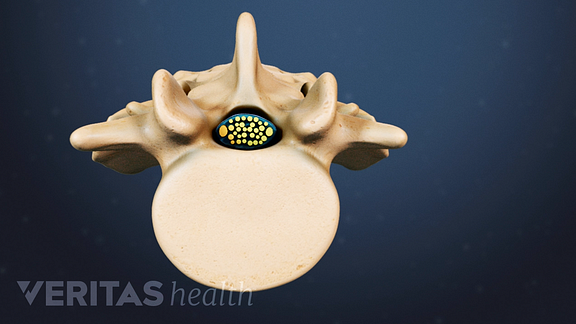术语“狭窄”得自希腊语,并且是指该变窄或收缩“扼流”脊神经的过程。的原因spinal stenosis在腰椎(下背部)通常与退行性变化,也被称为相关spondylosis,发生作为老化的结果。
椎管狭窄引起的脊髓神经的空间的收缩。看:腰椎管狭窄视频
Most commonly, lumbar spinal stenosis occurs when spondylosis causes one or more of the following changes in the spine:
- 小关节内改变,the small, stabilizing joints located between and behind vertebrae, which tend to get larger as they degenerate, compressing nearby spinal nerve roots.
- 在椎间盘的脱水,resulting in the collapse of the inner soft, jelly-like material, decreasing the space available for the spinal nerves.
- Thickening of the spinal ligaments椎管内,导致压缩力对脊髓和脊髓神经。
Stenosis in the lumbar spine may be diagnosed if degenerative changes have narrowed the bony openings of the spine and affected the nervous tissues, such as the spinal nerves, spinal cord, and/or the cauda equina.1
在后腰椎管狭窄是超过60岁的人更常见,通常会影响腰椎-L3的的下部L5脊水平,2这会导致症状辐射到腿部。
In the initial stages, these changes often produce symptoms of pain and/or cramping in the legs, especially with activity. Over time, the pain may become more constant or severe. Additional symptoms, such asnumbness and weakness也可发生。
本文提供了腰椎管狭窄症的全面的解释,包括症状,病因,和非手术及手术治疗选择范围。
腰椎管狭窄症的类型
当椎管狭窄影响脊髓神经,因为他们通过椎间孔(在下部脊柱的每一侧骨开口)中运行,该条件被称为椎间孔狭窄。上椎管侵占脊柱的缩小也有可能,被称为中央管狭窄。椎间孔和中央管狭窄可发生在同一时间,从而导致重叠症状。3
当腰椎管狭窄症与狭窄在不同的水平,如在颈椎(颈部)或胸椎(中背部)结合发生时,它被称为串联狭窄。
Depending on the location of the stenosis, various neural elements, such as the spinal nerve roots, spinal cord, and/or the cauda equina (nerves that descend from the spinal cord), may get compressed, leading to a combination of symptoms. These symptoms typically include (but are not limited to) pain, tingling, numbness, and/or weakness in the lower body, which presents as difficulty in walking.
看到Lumbar Spine Anatomy and Pain
在这篇文章中:
Typical Symptoms of Lumbar Spinal Stenosis
The characteristic symptom of lumbar spinal stenosis is increased pain in the legs with walking (neurogenic claudication or pseudo claudication), which can markedly diminish one's activity level. People with lumbar spinal stenosis are typically comfortable at rest but cannot walk far without developing leg pain. Pain relief is achieved within 5 to 10 minutes when they sit down or lean forward.4Spinal nerve root involvement may cause a more sharp, shooting type of pain in the leg.
腰椎管狭窄症的症状发展缓慢。随着病情的发展,症状会恶化,变得相当虚弱。对于每个人,的严重程度和腰椎管狭窄症的症状的持续时间是不同的,并且基于受影响的神经组织(一个或多个)。常见的症状可能包括一个或多个以下:
- 根性痛: Nerve root compression or irritation that results in leg pain, which typically travels down from the lower back into the buttock and leg on one side—commonly calledsciatica。
- 腰椎神经根病: Nerve root compression or irritation that results in tingling, weakness, and/or numbness that radiates from the lower back into the buttock and leg on one side.
- Neurogenic claudication:脊髓压迫引起的疼痛的影响两条腿行走时或站立的很长一段时间对称图案。神经功能障碍,如失去协调,步态失调,麻木,并影响了双腿,也可能出现疲软。
For most people, symptoms of lumbar stenosis fluctuate, with some periods of more severe symptoms and some with fewer or none. The symptoms develop gradually and can lead to chronic pain and muscle weakness over time. It is also possible for lumbar spinal stenosis to be asymptomatic (not cause any symptoms).五,6
Read more about腰椎管狭窄的症状
如何腰椎管狭窄发生
The majority of lumbar spinal stenosis diagnoses identify the cause as degenerative changes in the spine (spondylosis) due to aging.7The condition may also be caused by trauma, metabolic conditions, infections, or prior spinal surgery.
椎管狭窄也可能是在出生时出现,称为先天性椎管狭窄。1
The Course of Lumbar Spinal Stenosis
通常情况下,特定事件或损伤不会引起腰椎管狭窄症,条件随时间发展。腰椎管狭窄症,随着年龄的风险增加;条件是在人们在60岁更常见。2演示文稿和这种病症的症状的进展有很大的不同。早期症状可能包括后长时间站立后很长的步行或腿麻木感或achiness腿部(S)痉挛或不适。在后期,症状可发展到一边走一边是加剧了更严重的腿疼。
Lumbar spinal stenosis typically does not have a standard course of development and may not necessarily get more severe with time. While it has not been definitively studied, small some studies have shown that the course of this condition is variable, even for patients with the same type of stenosis.8
Over time, the symptoms may improve, worsen, or be intermittent with occasional flareups and/or activity-related pain.9
当腰椎管狭窄严重
While rare, it is possible for lumbar spinal stenosis to lead to serious complications. Immediate medical attention is warranted when the lumbar stenosis compresses the spinal cord and/or the cauda equina.
体征和症状,其指示这些组织的压缩典型地包括一个或多个以下内容:
- Almost intolerably severe lower back pain
- Severe sharp, shooting, and burning pain in the leg(s)
- Progressive weakness in one or both legs
- Numbness of the inner thighs (saddle anesthesia) and/or around the anal region
- Urinary retention
- 肠和/或膀胱控制(或者不能保持或释放)的损失
这些症状可能表明马尾综合征10(马尾神经压迫)或脊髓圆锥综合征11(脊髓的终端部分的压缩)。这些症状需要立即医疗干预,以保持腿部功能。
看到When Sciatica Pain Is a Medical Emergency
腰椎管狭窄症可引起轻度到严重的年代ymptoms, affecting daily life. While nonsurgical treatments are tried first, the patient may decide to have surgery if the symptoms are severe and cause significant dysfunction.
看到腰椎管狭窄症治疗
正如许多脊柱条件,卫生保健声称lpl竞猜外围ionals can advise on a range of nonsurgical and surgical treatments, and it is the patient’s choice to decide how to manage their condition. Foundational elements of almost every lumbar stenosis treatment program will include medication, physical therapy, exercise, and weight management. More invasive treatments, such as an epidural steroid injection or surgery, may be considered if the symptoms worsen and interfere with the patient’s mobility and everyday life. Surgical treatment shows better improvement when the symptoms are severe.6Lumbar spinal stenosis is the most common indication for spinal surgery in patients over 65 years of age.五
参考
- 1。Melancia JL, Francisco AF, Antunes JL. Spinal stenosis. In: Handbook of Clinical Neurology. Elsevier; 2014:541-549.DOI:10.1016 / b978-0-7020-4086-3.00035-7
- 2。Genevay S,阿特拉斯SJ。腰椎管狭窄症。最佳PRACT RES临床类风湿性关节炎杂志2010; 24(2):253-265。
- 3。帕特尔Ĵ,奥斯本I,Wanaselja A,贵族R.最优治疗腰椎管狭窄症。目前的意见中麻醉。2017; 30(5):598-603。doi:10.1097/aco.0000000000000495
- 4。Podnar S,VodušekDB。降低患者的周围神经系统病变尿路功能障碍。在:性和膀胱障碍的神经。爱思唯尔;2015:203-224。DOI:10.1016 / b978-0-444-63247-0.00012-2
- 5。Dixit R. Low Back Pain. In: Kelley and Firestein’s Textbook of Rheumatology. Elsevier; 2017:696-716.
- 6。Munakomi S,FORIS LA,Varacallo M.椎管狭窄神经性跛行。[2019更新9月6日]。在:StatPearls [互联网]。金银岛(FL):StatPearls出版;2019 Jan-。可从以下https://www.ncbi.nlm.nih.gov/books/NBK430872/
- 7。吴L,克鲁兹R.腰椎管狭窄症。[2019更新12月16日]。在:StatPearls [互联网]。金银岛(FL):StatPearls出版;2020 Jan-。可从以下https://www.ncbi.nlm.nih.gov/books/NBK531493/
- 8。南出A,吉田男,马尤K.腰椎管狭窄症的自然病程了:至少10年的纵向队列研究。Ĵ骨科科学。2013; 18(5):693-698。doi:10.1007/s00776-013-0435-9
- 9。劳瑞Ĵ,腰椎管狭窄症的Tomkins的巷C.管理。BMJ。2016年1月:h6234。doi:10.1136/bmj.h6234
- 10。伯格EJ,阿什赫斯特合资企业。解剖,返回,马尾。[2018更新12月6日]。在:StatPearls [互联网]。金银岛(FL):StatPearls出版;2019 Jan-。可从以下https://www.ncbi.nlm.nih.gov/books/NBK513251/
- 11。Nene Y, Jilani TN. Neuroanatomy, Conus Medullaris. [Updated 2019 Aug 3]. In: StatPearls [Internet]. Treasure Island (FL): StatPearls Publishing; 2019 Jan-. Available from:https://www.ncbi.nlm.nih.gov/books/NBK545227/







